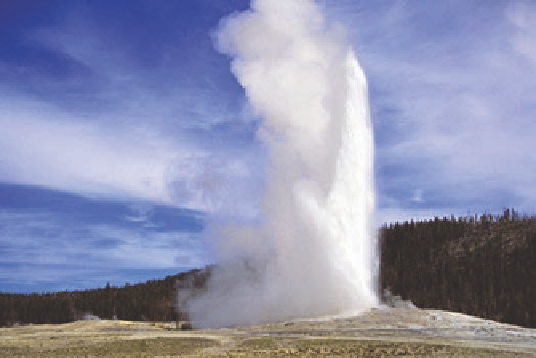Geoscience Reference
In-Depth Information
111
°
W
110
°
W
46° N
Bozeman
45
°
N
Yellowstone
National Park
2 million
years ago
Yellowstone Calderas
MONTANA
630,000 years ago
1.3 million years ago
MONTANA
IDAHO
630,000
years ago
6.5-4.3
mya
44° N
2 million years ago
Boise
Yellowstone
Lake
10.7
mya
1.3 million
years ago
Jackson
10.5-8.6
mya
Eastern
Snake River
Plain
44
°
N
0
50
km
0
50
mi
12-10.5
mya
16.5-15
mya
15-13
mya
42° N
(b)
UTAH
Figure 13.42 The Yellowstone Hotspot.
(a) Migra-
tion of the Yellowstone hotspot between 16 million
and 600,000 years ago. Although it appears that the
hotspot has moved, it is the North American plate that
has migrated toward the southwest. (b) Calderas in the
vicinity of Yellowstone National Park in northwest Wyo-
ming. Each of these calderas formed during individual
eruptions.
Great Salt
Lake
W
YO
MIN
G
0
50
km
Salt Lake City
N
0
50
mi
40° N
118
°
W
116
°
W
114
°
W
112
°
W
110
°
W
(a)
radiation, potentially causing a series of very cool years. Fortu-
nately for us, geologists believe that the next major eruption of
Yellowstone is thousands of years away.
Nevertheless, if you have been to Yellowstone, you know that
the underlying hotspot indeed remains active today. Geothermal
features such as geysers, mudpots, and fumeroles are very com-
mon within the park. A
geyser
is a superheated fountain of water
that suddenly sprays into the air on a periodic basis (Figure 13.43).
This process occurs because boiling water beneath Earth is con-
stricted as it rises through a subterranean passageway. When the
pressure builds sufficiently, the water bursts into the sky. When
the geyser has used all the water in its reservoir, it dies away until
the water is replenished from the surface or underground springs.
Geyser
A superheated fountain of water that suddenly sprays
into the air on a periodic basis.
Geyser
Hot spring
Superheated
water rising
to surface
Water heated
by contact
with hot rocks
Water heated
under pressure
(b)
Figure 13.43 Geothermal features at Yellowstone National Park.
(a) Schematic
illustration of geyser processes. Water below the Earth's surface is superheated and
rises in small cracks in the overlying rock. If a constriction exists in this rock, the heated
water backs up until the growing pressure causes it to blast toward the surface where
it erupts. (b) Old Faithful Geyser is probably the most famous system of its kind in the
world. It is so named because it erupts on average every 91 minutes.
Heated water
moves upward
Heat source,
Earth's interior
(a)








































